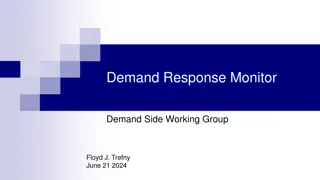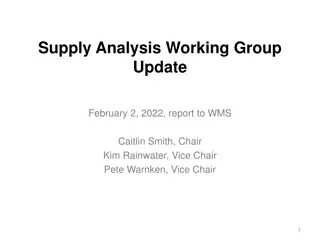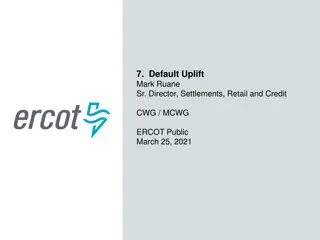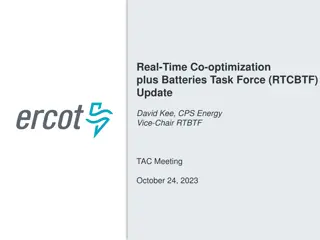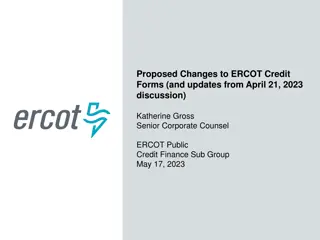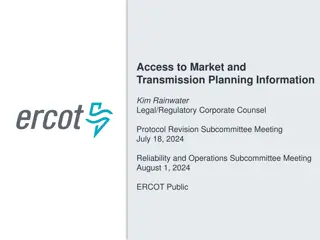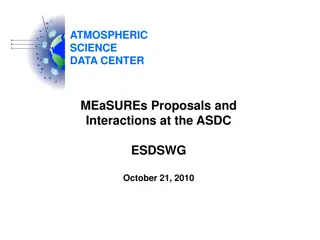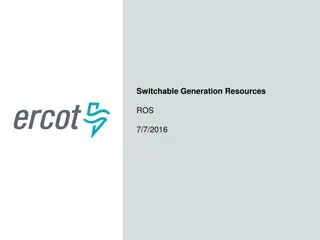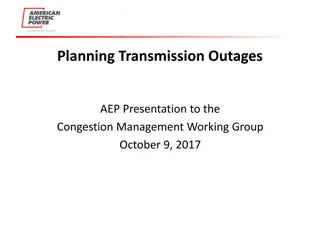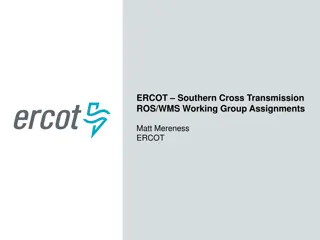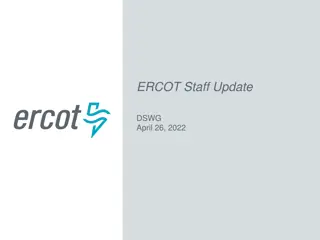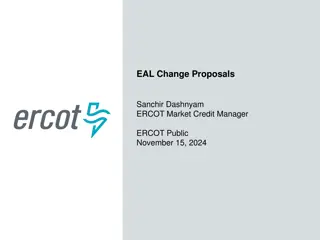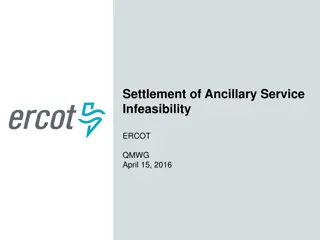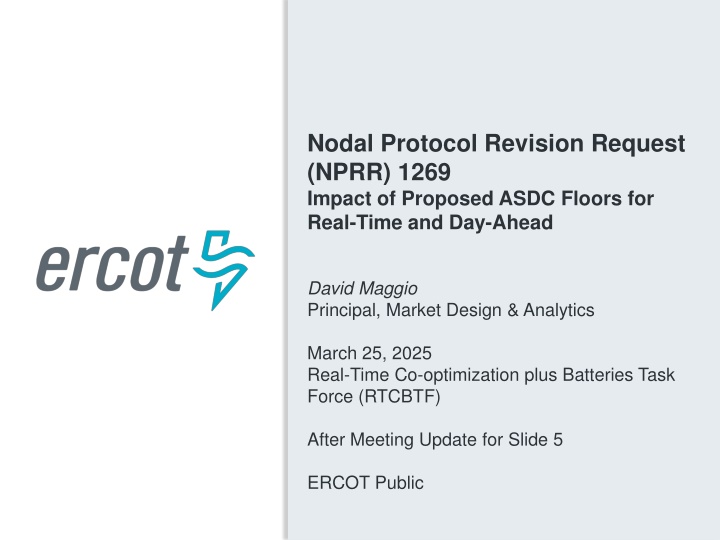
ERCOT's Perspective on ASDC Floors for Real-Time and Day-Ahead Markets
Explore ERCOT's viewpoint on implementing ASDC floors for the Day-Ahead and Real-Time Markets through NPRR 1269. Learn about the potential impacts and benefits of this proposed concept. Gain insights into the concerns raised by various stakeholders regarding Ancillary Service Demand Curves and Reliability Unit Commitment.
Download Presentation

Please find below an Image/Link to download the presentation.
The content on the website is provided AS IS for your information and personal use only. It may not be sold, licensed, or shared on other websites without obtaining consent from the author. If you encounter any issues during the download, it is possible that the publisher has removed the file from their server.
You are allowed to download the files provided on this website for personal or commercial use, subject to the condition that they are used lawfully. All files are the property of their respective owners.
The content on the website is provided AS IS for your information and personal use only. It may not be sold, licensed, or shared on other websites without obtaining consent from the author.
E N D
Presentation Transcript
Nodal Protocol Revision Request (NPRR) 1269 Impact of Proposed ASDC Floors for Real-Time and Day-Ahead David Maggio Principal, Market Design & Analytics March 25, 2025 Real-Time Co-optimization plus Batteries Task Force (RTCBTF) After Meeting Update for Slide 5 ERCOT Public
Introduction On March 3rd, ERCOT filed comments to NPRR1269 to codify specific numbers that were previously left as variables, while analysis and discussion at the Real-Time Co-optimization plus Batteries Task Force (RTCBTF) was ongoing. The comments were specific to the Ancillary Service Demand Curves (ASDCs) for Reliability Unit Commitment (RUC) and the Ancillary Service proxy offer floor parameters. On March 4th, TCPA filed comments to NPRR1269 to take the ASDC floor for RUC and apply it to the Day-Ahead and Real-Time Markets (DAM and RTM). This concept had been raised at the RTCBTF by market participants but had not yet been captured in proposed NPRR1269 language. Both the Texas Industrial Energy Consumers (TIEC) and Independent Market Monitor (IMM) filed comments to the NPRR in advance of the Protocol Revision Subcommittee (PRS) meeting expressing concerns about an ASDC floor in the DAM and RTM, among other things. This presentation is intended to provide ERCOT s perspective and analysis on potential impacts to the RTM in having the ASDC floor concept applied. It builds off of the presentation of similar analysis to PRS on March 12th. 2 PUBLIC
ERCOTs Perspective on the Concept of a ASDC Floor for the DAM and RTM, as Proposed by TCPA ERCOT is generally in favor in this concept moving forward: In light of Ancillary Service quantities we see today and in the near- term, there is a legitimate concern that DAM and RTM pricing may be insufficient to incent self-commitment of Resources for the tail amounts of Ancillary Services and may lead to increased RUC instructions, even when there is sufficient Resource capability otherwise. $15 per MW per hour (the ASDC floor proposed by ERCOT for RUC) is a relatively modest ASDC price for smaller levels of shortages and well below the minimum prices for Regulation Service (Reg) and Responsive Reserve Service (RRS) already included in NPRR1268. It can also allow Ancillary Service Offers below $15 per MW per hour to clear and support meeting the Ancillary Service Plan when that may not have been possible otherwise. 3 PUBLIC
ERCOTs Perspective on the Concept of TCPAs Comments cont. The distinction that this is a floor on the ASDCs and not a floor on the price for Ancillary Services is important. To the degree there are sufficient Ancillary Service offers and Resource capability, those offers would be setting the price, not the ASDCs. This is equivalent to what is seen in DAM today where current penalty prices are ~$5,000 per MW per hour, although that is almost never the clearing price. The deeper concern for those opposed to the concept seems to be the quantities that feed into the Ancillary Service Plan generally. A more thorough review of the process for determining these quantities is already underway with the development of a full statistical analysis tool and the consideration of closer to the Operating Day Ancillary Service quantity determination. If there are Ancillary Service quantity reductions, this concept will automatically adjust to account for that. 4 PUBLIC
ASDCs within the Optimization (Updated after meeting) Example ASDCs using the NPRR1268 Approach ASDCs are included as inputs into the optimization and represent a willingness to procure a volume of an Ancillary Service at a given price. The lower the price the more MW the optimization is willing to procure, and vice versa. Under NPRR1269, a floor on an ASDC then represents a maximum price that is willing to be paid to achieve the full Ancillary Service Plan published by ERCOT. To the degree there is sufficient Resource capability to meet demand for electricity and the Ancillary Service Plan, offers are generally driving prices, not the ASDCs. An ASDC floor can also allow more offers to be awarded. ASDCs and the proposed floors primarily come into play when procurement is short relative to the Ancillary Service Plan. 10,000 9,000 8,000 $/MW per hour 7,000 6,000 5,000 4,000 3,000 2,000 1,000 - - 2,000 MW 4,000 Reg-Up ECRS RRS Non-Spin Individual ASDCs are derived from the shape of the Aggregate Operating Reserve Demand Curve (AORDC). 5 PUBLIC
The Ancillary Service Plan and the AORDC As it stands today, the AORDC is guaranteed to go to $0 per MW per hour at 10 GW of Ancillary Services and goes to pennies per MW per hour well before that. In many hours, such as in May, the optimization is unwilling to procure the Ancillary Service Plan unless it would free or nearly free without an ASDC floor. While a floor will not affect the ASDCs at all in some hours, in others it may be the only means for procuring the Ancillary Service Plan, even if there is more than sufficient Resource capability that would otherwise be available. This is particularly relevant to ERCOT Contingency Reserve Service (ECRS) and Non-Spinning Reserve Service (Non-Spin). Summed 2025 Ancillary Service Plan by Hour and Month in MW (Excluding Reg-Down) 6 PUBLIC
Illustration of ASDCs with a Floor (ECRS and Non-Spin) ECRS Plan: 2,559 MW Non-Spin Plan: 1,942 MW Aug. '24 Hour Ending 20 Aug. '24 Hour Ending 20 6,000 100 $/MW per hour $/MW per hour 5,000 80 4,000 60 3,000 40 2,000 20 1,000 - - - 1,000 2,000 MW 3,000 4,000 - 1,000 2,000 MW 3,000 4,000 ECRS - No Floor ECRS - w/ Floor Non-Spin - No Floor Non-Spin - w/ Floor ECRS - No Floor ECRS - w/ Floor Non-Spin - No Floor Non-Spin - w/ Floor ECRS Plan: 2,514 MW Non-Spin Plan: 4,482 MW May '24 Hour Ending 14 May '24 Hour Ending 14 6,000 100 $/MW per hour $/MW per hour 5,000 80 4,000 60 3,000 40 2,000 20 1,000 - - - 1,000 2,000 3,000 4,000 5,000 MW - 1,000 2,000 3,000 4,000 5,000 MW ECRS - No Floor ECRS - w/ Floor Non-Spin - No Floor Non-Spin - w/ Floor ECRS - No Floor ECRS - w/ Floor Non-Spin - No Floor Non-Spin - w/ Floor 7 PUBLIC
Illustration of ASDCs with a Floor (ECRS and Non-Spin) cont. ECRS Plan: 1,555 MW Non-Spin Plan: 2,403 MW 6,000 $/MW per hour Oct. '24 Hour Ending 21 Oct. '24 Hour Ending 21 1,000 $/MW per hour 5,000 800 4,000 600 3,000 400 2,000 200 1,000 - - - 2,000 4,000 6,000 - 2,000 4,000 6,000 MW MW ECRS - No Floor ECRS - w/ Floor Non-Spin - No Floor Non-Spin - w/ Floor ECRS - No Floor ECRS - w/ Floor Non-Spin - No Floor Non-Spin - w/ Floor The actual effects of a floor on the ASDCs will vary by month and hour. For some hours, like this October period, there is no impact to the ASDCs whatsoever. In reviewing 2024, ASDCs for 32% of the month/hour ending combinations would not have been impacted by the ASDC floor proposal. For others, like the May period on the previous slide, the floor creates a long tail to encourage self-commitment to meet the Ancillary Service Plan when true scarcity does not otherwise exist. It also allows non-zero offers to help in meeting the Ancillary Service Plan. In all cases, the general shape of the ASDCs remains intact with the impact focused on the tail of the curves. 8 PUBLIC
Analysis Framework for RTM Impacts Scenarios Evaluated Case 1: Real-Time Co-optimization (RTC) without ASDC floors using max(min(2000, 95% )-0.01,0) for proxy floors Case 2: RTC with $15 per MW per hour ASDC floors using (min(2000, 95% ) 0.01) for proxy floors Case 3 (for prices): Derived from case 1 and 2 outputs to explicitly isolate the impacts of the ASDC floor and ignore impacts from proxy offer floors and the lack of Ancillary Service Offer data available for the simulations. If the ASDC floor sets the price for ERCOT Contingency Reserve Service (ECRS) or Non-Spinning Reserve Service (Non-Spin) in case 2, use the case 2 prices. Otherwise use the case 1 prices. Case 3 Ancillary Service procurement quantities are assumed equal to case 2 procurement quantities. Simulations of historical days are hampered by a lack of existing Real-Time Ancillary Service Offers. While we don t expect this to be a typical case in practice, this means that the simulation results can be dominated by proxy offers. Combined, cases 2 and 3 attempt to address this and provide the range of expected pricing outcomes with actual outcomes falling in between and being dependent on offer behavior. 9 PUBLIC
Analysis Framework for RTM Impacts cont. Dataset (~12,000+ intervals across 7 months and 216 Operating Days) Aug. 23 (hours ending 4-5, 13-14, and 20-21) Oct. 23 (hours ending 4-5, 13-14, and 20-21) Jan. 24 (hours ending 4-5, 13-14, and 18-19) Apr. 24 (hours ending 20-21) May 24 (hours ending 13-14) Aug. 24 (hours ending 4-5, 13-14, and 20-21) Oct. 24 (hours ending 4-5, 13-14, and 20-21) Months in bolded text are new or have expanded hours (as compared to the March 12th PRS material) to evaluate a wider range of operating conditions and to focus less specifically on net peak load hours. Metrics Count of intervals where the ASDC floor is setting the price Average price and total value of Ancillary Services and energy Average quantity of Ancillary Service procurements and shortages 10 PUBLIC
Summary of Results Across All Datasets Analyzed Intervals w/ ASDC Floor Setting the Price (ECRS or Non-Spin) Across the full study window, the ASDC floor for ECRS or Non- Spin set the price for only 177 intervals (1.4%). Average hourly procurement for ECRS and Non-Spin increases by ~92 MW (2.0%) Procurement increases are for intervals where shortages were relatively marginal, i.e., not deeper levels of scarcity. ASDC floors improve procurement amounts but shortages are not eliminated, and it should not be expected that all shortages are eliminated. 140 6% 120 5% Count of Intervals 100 4% % of Total 80 3% 60 2% 40 1% 20 0 0% Aug '23 Oct '23 Jan '24 Apr '24 May '24 Aug '24 Oct '24 Count % of Total Avg. Interval Increase in Procurement - Cases 2/3 Over Case 1 (ECRS and Non- Spin) 160 4% 140 120 3% MW Increase % Increase 100 80 2% 60 40 1% 20 0 0% Aug '23 Oct '23 Jan '24 Apr '24 May '24 Aug '24 Oct '24 MW % 11 PUBLIC
Summary of Results Across All Datasets Analyzed cont. Avg. Real-Time Prices for Energy and Ancillary Services 120 With the lack of Real-Time Ancillary Service offers, case 2 provides a higher-end evaluation of potential price changes. Case 3 numbers provide the other end of the range of outcomes. The increase in prices and values between cases 1 and 3 is negligible. Even with case 2 being more extreme: The change in overall prices and values is incremental with the percent increases in average energy prices and total energy value at 0.4% and 0.5%, respectively. While ECRS and Non-Spin prices increase, they are in alignment with other Ancillary Services and historical outcomes. The more extreme estimate of increased energy and Ancillary Service value combined is 1.1%. $/MWh & $/MW per hour 100 80 60 40 20 - Reg-Up RRS ECRS Non-Spin Energy Case 1 Case 2 Case 3 Total Real-Time Energy and Ancillary Service Value 250 5,000 200 4,000 $ Millions 150 3,000 100 2,000 50 1,000 - - Reg-Up RRS ECRS Non-Spin Energy Case 1 Case 2 Case 3 Value Measured as Price Multiplied by Awards (Base Points or Ancillary Services) 12 PUBLIC
Additional Analysis Details by Study Month and Case 13 PUBLIC
Average Ancillary Service Shortages by Month Studied Shortage Measured Relative to the Ancillary Service Plan 14 PUBLIC
Average Ancillary Service Shortages by Month Studied cont. Shortage Measured Relative to the Ancillary Service Plan 15 PUBLIC
Average Ancillary Service Procurement by Month Studied 16 PUBLIC
Average Ancillary Service Procurement by Month Studied cont. 17 PUBLIC
Average Real-Time Prices by Month Studied Energy and Ancillary Services 18 PUBLIC
Average Real-Time Prices by Month Studied Energy and Ancillary Services cont. 19 PUBLIC
Total Real-Time Energy and Ancillary Service Value by Month Studied Value Measured as Price Multiplied by Awards (Base Points or Ancillary Services) 20 PUBLIC
Real-Time Energy and Ancillary Service Value by Month Studied cont. Value Measured as Price Multiplied by Awards (Base Points or Ancillary Services) 21 PUBLIC
Conclusions There is a legitimate concern that DAM and RTM pricing may be insufficient to incent self-commitment of Resources for the tail amounts of Ancillary Services and lead to increased RUC instructions, even when there is sufficient Resource capability otherwise. $15 per MW per hour is a relatively modest ASDC price for smaller levels of shortages and the impact to average overall prices is minimal ($0.34/MWh, or 0.4% for the more extreme estimate of energy prices). The floors also help to lessen smaller levels of Ancillary Service shortages when there are sufficient competitive offers. For those more concerned about the Ancillary Service Plan quantities, a more thorough review of the process for determining these quantities is already underway. Any ASDC floor that is applied would automatically adjust and have less effect on outcomes overall. 22 PUBLIC



